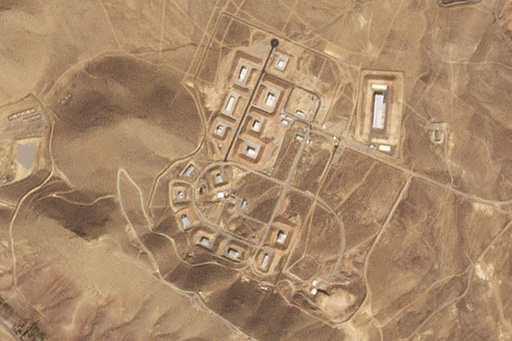DUBAI, United Arab Emirates — Recent satellite imagery has revealed that an Israeli airstrike in Iran has caused significant damage to facilities at a secret military base located southeast of Tehran. This area has previously been linked to Iran’s past nuclear weapons efforts, as well as to another base associated with its ballistic missile initiatives. The damage, examined through satellite photos, points to destruction at Parchin military base, where the International Atomic Energy Agency (IAEA) has suggested that high explosives tests were once conducted, potentially tied to nuclear weapon development. Although Iran maintains that its nuclear pursuits are intended for peaceful purposes, there is widespread belief among Western intelligence and the IAEA that a nuclear weapons program existed until 2003.
Additional damage is noted at Khojir military base, which experts speculate conceals an extensive tunnel network and missile production facilities. Despite the evident destruction, Iran’s military has not confirmed damage from the strike at either Khojir or Parchin. However, they reported that the assault resulted in the deaths of four Iranian soldiers working with air defense systems.
The Iranian government has not yet commented on the situation, and neither has the Israeli military. Nevertheless, Iranian Supreme Leader Ayatollah Ali Khamenei asked not to exaggerate or downplay the attack, indicating a level of caution rather than an immediate call for retaliation. Meanwhile, Israeli Prime Minister Benjamin Netanyahu claimed that the strikes inflicted severe damage upon Iran and successfully achieved their objectives.
The extent of the damage remains somewhat ambiguous, as the Iranian military has not released images showing the aftermath of the attack. Iranian officials pointed to affected regions, including Ilam, Khuzestan, and Tehran provinces. Satellite imagery captured around Iran’s Tange Bijar natural gas production site indicated burned fields, though their connection to the attacks was not confirmed. Parchin, approximately 40 kilometers (25 miles) southeast of Tehran, was particularly notable, showing a structure that appeared completely destroyed alongside others exhibiting some damage in the satellite images analyzed.
At Khojir, which lies 20 kilometers (12 miles) from central Tehran, damage was visible on at least two structures according to satellite imagery. Analysts, including experts from various defense think tanks, noted the damage and correlated their findings to videos that surfaced showing Iranian air defense systems in action during the strike.
The damaged building at Parchin, recognized as “Taleghan 2,” was identified by the Institute for Science and International Security, which highlighted its previous association with high explosive tests that could be part of nuclear weapon development scenarios. The institute mentioned that while it’s unclear if Iran used uranium at this location, the facility may have been involved in studies concerning uranium compression, which was suggested in a report following the IAEA’s request for access in 2011.
It is unknown what specific equipment might have been housed within the destroyed “Taleghan 2” building prior to the attack. Notably, the Israeli strikes did not target Iran’s oil infrastructure, nuclear enrichment facilities, or the Bushehr nuclear power plant. Rafael Mariano Grossi, head of the IAEA, confirmed through social media that the nuclear sites in Iran were not affected, emphasizing the continued safety and work of inspectors.
According to analysts, additional damaged buildings at Khojir and Parchin likely included facilities for creating solid fuel required for Iran’s ballistic missile arsenal. Following the attack, the Israeli military stated it aimed for missile production facilities utilized for launching attacks against Israel over the previous year. The destruction of such facilities could disrupt Iran’s ability to restock its missile capabilities after ongoing confrontations with Israel.
The overall estimate of Iran’s ballistic missile stockpile, which encompasses shorter-range missiles that cannot reach Israel, was noted as being over 3,000 in a previous report by a U.S. military official. In recent years, Iran has launched numerous missile strikes in various operations. Unlike Iranian missiles, the precision of Israel’s airstrike appears to have minimized collateral damage, as there were no reports of missile debris or destruction in civilian areas following the recent attack.
Despite this, damage was reported at Shamsabad Industrial City, a region south of Tehran near the country’s main international airport. Online videos showed damage to a facility linked with TIECO, a company that specializes in advanced machinery for the oil and gas industry in Iran. Officials from TIECO requested formal correspondence from the press before providing comments, and no immediate response was received after a letter was sent.


